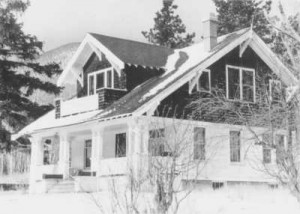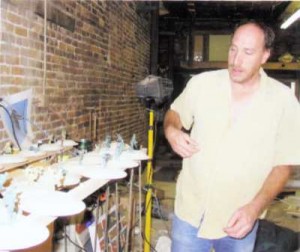Review by Abby Quillen
Colorado history – December 2003 – Colorado Central Magazine
The Mineral Palace
by Heidi Julavits
Published in 2000 by G.P. Putnam’s Sons
Republished in paperback in 2003
ISBN 0-399-14622-9
DURING THE DUST BOWL YEARS of the 1930s, the West was a sea of dead grass and bone white dirt, of abandoned towns, empty buildings, and unpopulated streets. Heidi Julavits masterfully describes the desperate landscape in Mineral Palace, a novel about Bena Jonssen, the wife of a doctor and the mother of a newborn, who moves from Minnesota to Pueblo, Colorado in the midst of the Great Depression.
Pueblo is barren, drab, and unseasonably hot the summer they arrive in their Ford touring car. The dust storms that continually rip into town strip the paint off cars, take the leaves from trees, and force Bena to barricade herself and her baby in the house and hang wet bed sheets over the windows to keep out the dust.
With local headlines announcing an outbreak of “Dust Pneumonia” and a child’s death from suffocation, Bena, who is prone to superstition anyway, becomes increasingly concerned about her baby’s health. She’s convinced that he’s not developing quite right. And she’s also distraught because her marriage, which she’d hoped would become stronger after the move west, is as troubled as ever.
Depressed, Bena decides that working outside of her home might lessen her bleak mood, so she gets a job reporting on society women for the Pueblo Chieftain.
But then she becomes increasingly interested in the darker side of life in Pueblo, which she gets glimpses of from her window at work. Bena watches people coming and going from Buck’s Silo, a rowdy bar, and becomes so intrigued by a pregnant prostitute and her cowboy companion that she makes an effort to befriend them.
What follows is a surprising series of events that Bena must grapple with — while simultaneously dealing with problems at home, and with ghosts from her past that have haunted her for years.
Mineral Palace is a textured novel, full of twists and turns and punctuated by heartbreaking revelations. And it’s told in prose that’s as lyrical as poetry. The fast-paced, multi-layered plot and Julavits’ dark, metaphoric writing will keep you reading. And if you’re a Colorado history buff, you will delight in her deft descriptions of formidable dust storms and the Great Depression.
The book is named for Pueblo’s famed Mineral Palace, a lavish, sprawling building with sphere-topped columns, which opened its doors in 1891 as part of a campaign to promote mining during the bonanza era. The Mineral Palace displayed a collection of Colorado ores and geological specimens until it closed its doors in 1935. Julavits resurrects this massive building in the pages of her novel.
But by the time Bena encounters the palace, it is as run-down and desperate as the Depression era landscape. The dank interior is teeming with mice, it stinks of mold and mildew, and it is full of decadent objects — fake stalactites, marble lions, velvet pillows, chandeliers, and silver statues — that were probably once-beautiful, but seem ridiculous in their decrepit state.
The scenes from the Mineral Palace will stay with you after you put the book down, as will Julavits’ descriptions of the dusty streets of Pueblo, a once great town which lost its influence to Denver in the early part of the 20th Century.
The author’s presentation of Colorado during our nation’s great economic crisis is certainly not favorable. Take this bit of insight from the fictional mouth of Bonnie Parker, of Bonnie and Clyde fame, who has a brief cameo in the book: “Not much to Colorado, really. Space. More space. Nothing to be done with it, being it’s all mountains or desert. Sort of like a rich widow in her mansion. Thousands of rooms to rattle around in, but no use to make of them.”
However, Julavits describes the landscape surrounding Pueblo and Colorado Springs in such a way that you’ll probably remember what it is you love about Colorado, too — despite her uncomplimentary depiction.
For instance, when Bena is on her way to an interview at the Chieftain, she stops and catches her breath, because, “there, between the two buildings, an unfettered view of the Rockies muscled skyward from the colorless plain, the peaks flecked with snow. The mountains were pristine and magnificent through the brown haze, and appeared to move across the flatlands like a great, ragged tidal wave promising to wash the streets and buildings clean.”
Mineral Palace rings with the sort of truth that you find in good fiction, because it is about characters who are as fallible as real people — rather than heroic, epic, gallant, courageous and bold. And the setting is so well crafted that it’s like taking a trip to 1930s Colorado. This is historical fiction at its best.


